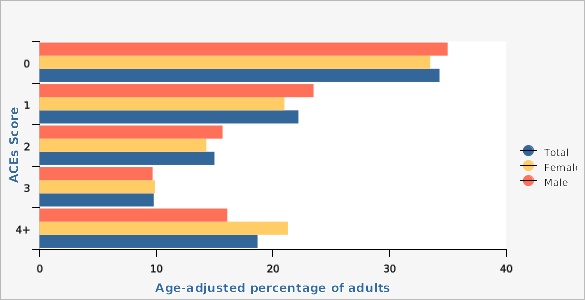PHOM Indicator Profile Report of Adverse Childhood Experiences (ACEs)
Why Is This Important?
Childhood experiences, both positive and negative, have a tremendous impact on future violence victimization and perpetration, and lifelong health and opportunity. Exposure to ACEs may result in toxic stress responses that can impede a child's development, such as changes in gene expression, changes in brain connectivity and immune function, and changes in the type of coping strategies adopted. While many coping strategies are healthy and help reduce acute stress, some (e.g. smoking cigarettes, drinking alcohol, using substances, engaging in risky sexual behavior) present additional risks to health and wellbeing. As such, exposure to early adversity can increase the risk of later chronic and infectious health conditions through changes in physiological mechanisms, as well as increased engagement in health risk behaviors, and can ultimately result in premature death. ACEs are common; as nearly two-thirds (63.9%) of surveyed U.S. adults experienced at least one ACE and many adults experienced more than one. Some populations are more vulnerable, however, to experiencing ACEs, such as children living in poverty and racial and ethnic minorities, because of the structural and social conditions in which some children and families live, learn, work, and play. It is important to remember that ACEs are preventable, and when present their effects can be mitigated with the help of healthy relationships.In Utah, 65.7% of adults have experienced at least one ACE, and over one in four have experienced three or more (28.5%). Among Utah women, 31.2% experienced three or more ACEs compared with 25.8% of men, a statistically significant difference. Females affirmed experiencing more household substance abuse, house mental illness, domestic violence, and emotional abuse. Also, females were two times more likely to affirm experiencing sexual abuse than males. Males affirmed experiencing more physical abuse and incarcerated household members.
Data Source
Utah Department of Health and Human Services Behavioral Risk Factor Surveillance System (BRFSS) [https://ibis.health.utah.gov/ibisph-view/query/selection/brfss/BRFSSSelection.html]Data Notes
All questions refer to the time period before respondents were 18 years of age. [[br]][[br]] Age-adjusted to the U.S. 2000 standard population.Date Indicator Content Last Updated: 02/29/2024
Other Views
- Prevalence by Type, Utah, 2022 and U.S. 2011-2020
- Prevalence by Score and Gender, Utah, 2018, 2020, and 2022
- (4+ACEs) by Ethnicity, Utah, 2018, 2020, and 2022
- (4+ACEs) by Race, Utah, 2018, 2020, and 2022
- Prevalence by Type and Disability Status, Utah, 2018, 2020, and 2022
- (4+ACEs) by Income, Utah, 2018, 2020, and 2022
- (4+ACEs) by Local Health District, Utah, 2018, 2020, and 2022
- (4+ACEs) by Utah Small Area, Utah, 2018, 2020, and 2022

